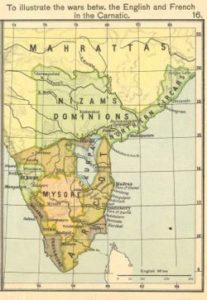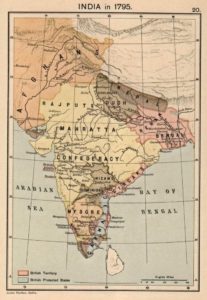The Governor Generals of India
Early timeline before of the British East India Company before the governor generals of India
| 1600 | East India Company was given monopoly privileges on all trade with the East Indies |
| 1608 | The Company’s ships arrived at the port of Surat |
| 1615 | Sir Thomas Roe reached the court of the Mughal Emperor, Jahangir, as the emissary of King James I, and gained for the British the right to establish a factory at Surat. |
| 1717 | EIC received a firman exempting the Company from the payment of custom duties in Bengal |
| 1756 – 1763 | Seven Years War in Europe |
| 1756 | The Siege of Calcutta The Nawab of Bengal Siraj-Ud-Daulah aimed to recapture the city of Calcutta from European control, after tensions had risen due to the East India Company building fortifications in case of French attack as part of the Seven Years’ War. Fort William – containing the entire European population of the city – fell almost immediately, leaving the city in Indian hands |
| 1757 | British forces under Robert Clive recaptured Calcutta, defeated the forces of the Nawab of Bengal, Siraj-ud-daulah a French ally, and ousted him from his throne at the Battle of Plassey |
| 1760 | British commander Eyre Coote decisively defeated the Comte de Lally at the Battle of Wandiwash and overran the French territory of the Northern Circars. |
| 1764 | The combined army of Mir Qasim, the Nawab of Bengal; the Nawab of Awadh; and the Mughal King Shah Alam II fought with forces under the command of the British East India Company. Decisive victory for the British |

The Governor Generals of India can be divided into four distinct classes
- Governors of Fort William in Bengal (1757-1772)
- Governor Generals of Bengal(1773-1833): The Regulating Act of 1773 created the office with the title of Governor General of Bengal
- Governor Generals of India(1833-1858): The Saint Helena Act 1833 (or Government of India Act 1833) re-designated the office with the title of Governor-General of India
- Viceroy and Governor Generals of India(1858-1948): After the Indian Rebellion of 1857, the Government of India Act 1858 created the office of Secretary of State and also added the term Viceroy of India to the office, to be formally known as Viceroy and Governor-General of India (1858-1948). After 1858, Viceroy Of India , as a Viceroy, direct representative of the Crown, dealt with the princely states of India, whose relationship was not with the British government, but directly with the monarch. And as a Governor General, govern the British India provinces.
-
Governors of Fort William in Bengal (1757-1772)
- Roger Drake (1757)
- Robert Clive (First Administration; 1757-1760)
- Holwell (Officiating; 1760)
- Henry Vansittart (1760-1765)
- Robert Clive (Second Administration; 1765-1767)
- Established Dual Government in Bengal from 1765-72
- Bengal White Mutiny by white brigades at Allahabad and Monghyr
- Harry Verelst (1767-1769)
- Cartier (1769-72)
Regulating Act of 1773
By 1773 the East India Company was in dire financial straits and asked for assistance from the British Government. Faced with corruption and nepotism amongst the company officials in India, the British Government enacted the Regulating Act in 1773 to control the activities of the Company. The Act set up a system whereby it supervised (regulated) the work of the Company but did not take power for itself.
-
Governor-General of Bengal (1773-1833)
- Warren Hastings (1773-85): First of the governor generals of India. Introduced regulating act in 1773 which brought dual government in Bengal to an end. Established a more understanding relationship with India’s inhabitants and their rulers
| Administrative reforms | End of the dual systems; shifting of treasury froom Murshidabad to Calcutta. |
| Revenue reforms | Collection of revenue was taken over by the Company. |
| Judicial reforms | Zamindars were given judicial powers; establishment of civil and criminal courts in each district. |
| Social reforms | In 1781, he founded the Calcutta Madrasa for promotion of Islamic studies. This was the first educational institute established by the Company’s government. |
| Impeachment | Warren Hastings tendered his resignation in protest against the Pits India Bill in 1785. He was accused for the Rohilla bar; Nand Kumar’s murder; the case of the Chet Singh and accepting of bribes. His impeachment lasted for seven years from 1788 to 1795. He was exonerated for all the charges. |
Pitts India Act: The East India Company Act 1784, also known as Pitt’s India Act, was an Act of the Parliament of Great Britain intended to address the shortcomings of the Regulating Act of 1773 by bringing the East India Company’s rule in India under the control of the British Government. Pitt’s India Act provided for the appointment of a Board of Control, and provided for a joint government of British India by both the Company and the Crown with the government holding the ultimate authority.
- John Macpherson(1785-86): Transitionary
- Cornwalis(1786-93): Enacted numerous significant reforms within the East India Company and its territories, including the Permanent Settlement, an agreement between east India company and Bengali landlords to fix revenues raised from land. From 1789 to 1792 he led British and Company forces in the Third Anglo-Mysore War to defeat the Mysorean ruler Tipu Sultan.
| Lord Cornwallis (1786-1793) | |
| Permanent settlement of Bengal | The land was given on permanent basis to the zamindar in 1793, instead of giving it to the highest bidder each year. This system got prosperity to both the Company and zamindar had the cost of the common peasantry. |
| Judicial reforms | Reorganisation of the revenue courts; the reorganisation of the criminal courts; depriving the Collectors of the judicial functions; compilation of the Cornwallis Code. |
| Police reforms | Depriving zamindar of their police functions; establishment of the thanas |

- John Shore(1793-98): Followed a policy of non intervention
- Alured Clarke(1798-98): Transitionary
- Wellesley(1798-1805): Introduced the Subsidiary Alliance system where the Indian ruler agreed to keep British forces in his territory. Opened a college to train the companys servants in Calcutta. That is why he is called the Father of Civil Services in India
- Cornwalis(1805-05): Appointed again but died soon after
- Sir George Barlow (1805-1807): Mutiny of Vellore in 1806 in which the Indian soldiers killed many English officials
- Minto I (1807-1813): His rule famous for a treaty with Shah of Persia and Treaty of Amritsar (1809) with Ranjit Singh. Recent Sir Charles Metcalfe to the court of Ranjit Singh.
- Earl of Moira(1813-23)(Also took surname hastings): He was the first to appoint Indians to the highest Ops of responsibility. The first vernacular newspaper Samahar Patrika begin to be published during his time.
- John Adam(1823-23): Acting
- Amherst(1823-28): First Anglo Burmese War (1824-26) and mutiny of Barrackpur (1824)
- Bayley(1828-28): Acting
- William Bentick(1828-33): Started as Governor General of Bengal. Became Governor General of India in 1833.
| Lord William Bentinck (1828-1833) | |
| Administrative and judicial reforms | Abolition of provincial courts of appeal and circuit, power of the magistrate increased, appointment of Indians as judges, replacement of Persian by vernaculars and Scott language, introduction of the residuary system, Sardar Diwani Adalat at Allahabad; Codification of Laws. |
| Educational reforms | English accepted as the medium of instruction after the famous Macaulay’s recommendation; Medical colleges at Calcutta in 1835. |
| Social reforms | Abolition of sati in 1829. Suppression of thuggee in central India; banning of female infanticide; banning of human sacrifice; reform in the Hindu Law of Inheritanc |
-
Governor Generals of India (1833-1858)
- William Bentick(1833-35)
- Charles Metcalfe(1835-36): He held the post temporarily. He removed the restriction on the vernacular press.(Called Liberator of the Press)
- Auckland(1836-42): Outbreak of first Afghan For and the signing of a Tripartite Treaty among the English, Ranjit Singh and Shah Shuja of Afghanistan.
- Ellenborough(1842-44): His period is known for the end of the first Afghan war, annexation of Sindh to the British Empire (1843)
- Bird(1844-44):Transition
- Hardinge(1844-48): First Sikh War (1845-1846)
| Governor Generals of India: Lord Dalhousie (1848-1856) | |
| About Lord Dalhousie | He was the youngest to hold the office of the Governor General. He is famous for the the Doctrine of Lapse . The second Burnese war, 1852, took place because of Lord Dalhousie’s desire to exclude all European power from Burma. The second Anglo Sikh War and did Sikh power and Punjab was annexed. |
| Administrative reforms | Separate Lieutenant Governor appointed for Bengal; Shimla made the summer capital. |
| Military reforms | Arillery Headquarters moved from Calcutta to Merrut; Army headquarters shifted to Shimla; formation of Gurkha regiments. |
| Railways | First railway line was led from Bombay to Thana, in 1853. |
| Post and Telegraph | Reforming the defects of the Postal System and linking all the important towns Telegraphically. |
| Education | Served Charles Woods despatch on Education (1854) recommended the setting up of universities in Calcutta, Bombay and Madras. In 1853, competitive examination for the Indian Civil Services beg |
- Canning(1856-58): Annexation of Avadh; enactment of Hindu Widow Remarriage Bill, 1857; establishment of universities at Calcutta, Madras and Bombay; the revolt of 1857 who were some of the important events during his post of Governor General.
- Viceroy and Governor Generals of India (1858-1948)
Lord Canning (1858-1862): Following the Queen’s recommendation in 1858, transferring the Government from the company to the British Crown, Lord Canning was made the first Viceroy of India. Important developments in his regime were as follows:
- 5% income tax was imposed on all are links beyond Rs. 500 a year.
- Penal code was prepared by incorporating the suggestions earlier made by the First Law Commission headed by Lord Macaulay. High courts were set up at Calcutta, Bombay and Madras under the provisions of the Indian High Courts act of 1861.
- Elgin(1862-63): Suppression of the Wahabi tribe of the fanatic Muslims inhabiting the North West Frontier.
- Napier(1863-63):
- Denison(1863-64):
- Lawrence(1864-69): An important event of this time was war against Bhutan in 1865. The Punjab and Oudh Tenancy Act, 1860, was enacted. Two famines hit India; first in 1800 in Orrisa and second in 1868-69 in Bundelkhand and Rajputana. A Famine Commission was set up under the chairmanship of Sir Henry Campbell.
- Mayo(1869-72): For the first time in Indian history census was held in 1871. A college was setup and Ajmer to impart suitable education to the sons of the Indian princess. Subsequently, this college came to known as the ‘Mayo College”. And agricultural department was setup. In 1872, a convict Sher Ali stabbed him to death at Port Blair.
- Strachey(1872-72):Acting
- Napier(1872-72):Acting
- Northbrook(1872-76): Deposition of Gaekwad in 1874; the Kuka movement; visit of Prince of Wales; abolition of income tax; famine in Bihar and Bengal in 1873-1874.
- Lytton(1876-80):
- Famine in 1876-1878; Famine Commission was appointed in 1878 headed by General Richard Strachey.
- The Delhi Durbar, January 1, 1877, was held to decorate Queen Victoria with the title Kaiser-i-Hind.
- The Vernacular Press Act, 1878 was passed, putting several curbs on the vernacular newspapers.
- Indian Arms act, 1878 forbade the Indian people from keeping or deeling in arms with the permission of the Government.
- Foundation of the Mohammedan Anglo-Oriental College was laid by Lord Lytton in 1877 at Aligarh.
- Statutory Civil Service in 1879. It was also laid down that the candidates had to appear and pass the civil services examination which began to be held in England. The maximum age for these candidates were reduced from 21 to 19 years.
- Ripon(1880-84):
- Important events during Ripon’s stint as viceroy were as follows:-
- Repeal of Vernacular Press act, 1882.
- Resolution in 1882 for institution of local self-government in India.
- Constitution of the Hunter commission on education (1882).
- The maximum age of admission to civil services raised to 21.
- Introduction of the Ilber Bill which would authorize India judges to hear cases against the Europeans as well.
- Dufferin(1884-88):
- His period witnessed the third Anglo Burmese war which led to the accession of upper Burma. Three Tenancy Acts were passed to give greater security of tenure or to the tenants.
- Indian national Congress formed
- Lansdowne(1888-94): Indian Council Act was passed in 1892. Durand Commission was appointed to demarcate the line between British India and Afghanistan
- Elgin II (1894-99): A bubonic plague in Bombay in 1896 and sever draught in Bikaner and Hissar distric
- Curzon(1899-1905): partition of Bengal
- Minto II(1905-10): Indian Council Act 1909 or Morley Minto reforms passed which provided for separate electorate to Muslims.
- Hardinge II (1910-1916): In the honour of King George V and Queen Mary of England, Coronation Darbar was held at Delhi. In 1911 the capital of country was announced to be shifted from Calcutta to Delhi. In 1912, Delhi became the new capital. When Lord Hardinge was heading a procession through the Chandi Chowk in his new capital, some extremist revolutionaries through a bomb burn him. The Viceroy himself escaped unhurt. The First World War broke out in 1914. In 1916, Lord Hardinge laid the foundation of the Benaras Hindu University. Madan Mohan Malaviya was the Founder-Chancellor of this university.
- Chelmsford (1916-1921):Enactment of the Government of India, 1919 (Montague-Chelmsfor Reforms) which introduced dyarchy in the provincess; enactment of Rowlatt Act (1919); the Jallianwala Bagh Tragedy (1919); and the beginning of the Non-cooperation Movement were some of the important events in his period.
- Reading (1921-1926): Non-Corporation Movement (1922); arrival of the Prince of Wales (1921); and outbreak of the Moplah Revolt (1921) was some of the events of his period. Chauri Chaura incident. Gandhi imprisoned for the first time
- Irwin (1926-1931): First Round Table Conference, Simon Comission Gandhi Irwin pact and the famous dandi march(Launching of the civil Disobedience movement), Passing of the resolution for complete independence (purna smarajya) in 19293
- Willingdon (1931-1936): The second Around Table Conference, 1931, Restarting of the Disbodience Movement, 1931, The communal award, 1932; the Poona act; Third Round Table Conference, 1932, The Government of India Of 1935; Earthquake in Bihar on January 15, 1934.
- Linlithgow (1936-44): Longest reign as viceroy of India, Beginning of the Second World War. Coming into force of the Government of India Act 1935. Arrival of the Cripps Mission. Beginning of the Quit India Movement, Great Famine of Bengal (1943)
- Wavell (1944-1947): Shimla conference, 1945; arrival of the Cabinet Mission, 1946; the Constituent Assembly boycotted by the Muslim League which launched the heinous “Direct Action Day” on August 16, 1946; the Intrim Government under Pt. Jawajarlal Nehru’s leadership; Attlee’s Declaration that his government was intended to hand over the Administration of India to her people before June 1948, even if no agreement was reached between the Congress and the Muslim League.
- Mountabatten (1947-1948): Declaration of third June, 1947; Indian Independence Act, Partition of the country between two independent states of India and Pakistan with Lord Mountbatten and Mr M.A. Jinnah as thier respective Governor generals. Succeeded by C. Rajagopalachari, the first and last governor general of free India.
Main Article: Governor Generals of India Keyword: Governor Generals of India
Tags:
Governor Generals of Bengal: Warren Hastings
Governor Generals of Bengal :John Macpherson
Governor Generals of Bengal: Cornwallis
Governor Generals of Bengal: John Shore
Governor Generals of Bengal: Alured Clark
Governor Generals of Bengal: Wellesley
Governor Generals of Bengal: Cornwalis
Governor Generals of Bengal: Sir George Barlow
Governor Generals of Bengal: Minto I
Governor Generals of Bengal: Earl of Moira
Governor Generals of Bengal: John Adam
Governor Generals of Bengal: Amherst
Governor Generals of Bengal: Bayley
Governor Generals of Bengal: William Bentick
Governor Generals of India: William Bentick
Governor Generals of India: Charles Metcalfe
Governor Generals of India: Auckland
Governor Generals of India: Ellenborough
Governor Generals of India: Bird
Governor Generals of India: Hardinge
Governor Generals of India: Canning
Governor Generals of India: Elgin
Governor Generals of India: Napier
Governor Generals of India: Dension
Governor Generals of India: Lawrence
Governor Generals of India: Mayo
Governor Generals of India: Strachey
Governor Generals of India: Napier
Governor Generals of India: Northbrook
Governor Generals of India: Lytton
Governor Generals of India: Ripon
Governor Generals of India: Dufferin
Governor Generals of India: Lansdowne
Governor Generals of India: Elgin II
Governor Generals of India: Curzon
Governor Generals of India: Minto II
Governor Generals of India: Hardinge II
Governor Generals of India: Chelmsford
Governor Generals of India: Reading
Governor Generals of India: Irwin
Governor Generals of India: Willingdon
Governor Generals of India: Linlithgow
Governor Generals of India:Wavell
Governor Generals of India: Mountbatten

The package consists of summaries of curated sources for studying the most critical subjects of UPSC in the most comprehensive manner. The summaries are prepared in consultation with exam toppers and serving/retired civil servants along with our own team of experts who ensure that you refer to the most relevant content in your preparation journey.
In the current exam scenario the bigger challenge is not the lack of material but the availability of excessive material that often confuses aspirants. Hence this package is our endeavor to minimize wastage and maximize utilization of an aspirants precious time. What will also be of interest to you is the fact that unlike many other institutions we have prepared the whole package in an editable format so that you can easily edit, append, delete the notes to suit your current preparation.
Quality of the notes is our most important focus. Coming from the house of PSCPREP you can be rest assured that the notes are of the topmost quality.